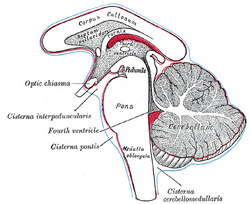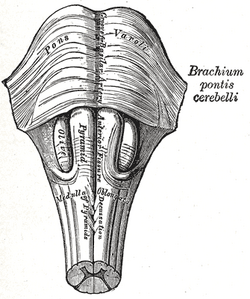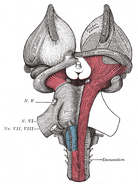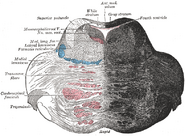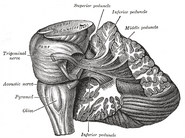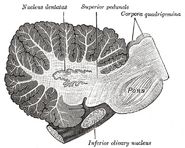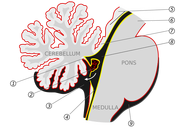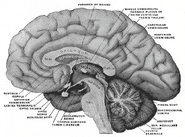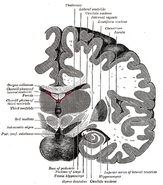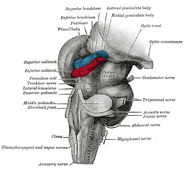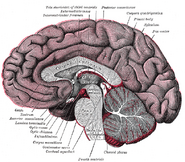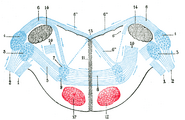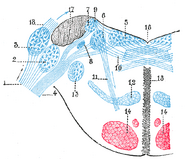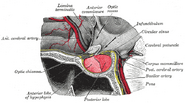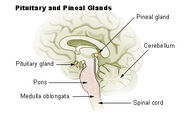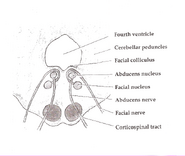Assessment |
Biopsychology |
Comparative |
Cognitive |
Developmental |
Language |
Individual differences |
Personality |
Philosophy |
Social |
Methods |
Statistics |
Clinical |
Educational |
Industrial |
Professional items |
World psychology |
Biological: Behavioural genetics · Evolutionary psychology · Neuroanatomy · Neurochemistry · Neuroendocrinology · Neuroscience · Psychoneuroimmunology · Physiological Psychology · Psychopharmacology (Index, Outline)
| Brain: Pons | ||
|---|---|---|
| Diagram showing the positions of the three principal subarachnoid cisternæ. (Pons visible at center.) | ||
| Anteroinferior view of the medulla oblongata and pons. | ||
| Latin | {{{Latin}}} | |
| Gray's | subject #187 785 | |
| Part of | Brain stem | |
| Components | ||
| Artery | pontine arteries | |
| Vein | transverse and lateral pontine veins | |
| BrainInfo/UW | hier-538 | |
| MeSH | A08.186.211.132.810.428.600 | |
The pons (sometimes pons Varolii after Costanzo Varolio) is a structure located on the brain stem making part of the hindbrain. It is cranial to the medulla oblongata, caudal to the midbrain, and ventral to the cerebellum. In humans and other bipeds this means it is above the medulla, below the midbrain, and anterior to the cerebellum.
Function
The pons relays sensory information between the cerebellum and cerebrum; aids in relaying other messages in the brain; controls arousal, and regulates respiration (see respiratory centres). In some theories, the pon has a role in dreaming.[1]
Anatomy of the pons
The "knob-like" process (Basal pons) is 2 centimeters long and located on the anterior (front) of the brainstem. It is formed of nerves that travel from one side (left or right) to the other. Most other fibres in the brainstem travel up and down.
The posterior (back) surface of the pons forms part of the wall of the fourth ventricle of the brain.
Most blood to the pons is supplied by pontine arteries. These are small arteries that branch off the basilar artery of the Circle of Willis. Blood also comes from the anterior inferior, and superior cerebellar arteries.
There are two main domains in the pons for control of respiration:[2]
- the apneustic center - lower pons
- the pneumotaxic center - upper pons
Cranial nerve nuclei
A number of cranial nerve nuclei are present in the pons:
- mid-pons: The chief or pontine nucleus of the trigeminal nerve sensory nucleus (V)
- mid-pons: the motor nucleus for the trigeminal nerve (V)
- lower down in the pons: abducens nucleus (VI)
- lower down in the pons: facial nerve nucleus (VII)
- lower down in the pons: vestibulocochlear nuclei (vestibular nuclei and cochlear nuclei) (VIII)
Related diseases
- Central pontine myelinosis, a demyelination disease that causes difficulty with sense of balance, walking, sense of touch, swallowing and speaking to mention just a few symptoms. In a clinical setting it is often associated with transplant. Undiagnosed it can lead to death or 'locked in' syndrome.
See also
Additional images
References
- ↑ The "Science of Dreaming" in Neurontic: Psychology for the Modern Mind..
- ↑ Physiology at MCG 4/4ch6/s4ch6_10
External links
| This page uses Creative Commons Licensed content from Wikipedia (view authors). |
